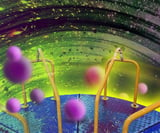Persistent Gravitational Wave Hum Reveals Supermassive Black Hole Collisions, Solves Astronomy's Final Parsec Problem
July 23, 2024
A study published in July 2024 in Physical Review Letters was co-authored by Gonzalo Alonso-Álvarez, Professor James Cline, and Caitlyn Dewar from McGill University and CERN.
In 2023, a gravitational chirp of gravitational waves in space was discovered.
The background hum of gravitational waves from colossal cosmic collisions, detected by the Pulsar Timing Array, consists of longer wavelength waves.
The persistent 'hum' of gravitational waves detected in 2023 is attributed to the merging of massive supermassive black hole pairs, each billions of times the mass of the Sun.
Pairs of supermassive black holes can merge due to the behavior of dark matter particles, addressing the 'final parsec problem' in astronomy.
Insights from research on supermassive black hole mergers and gravitational waves also contribute to understanding dark matter particles.
Dark matter particles interact in a way that degrades supermassive black hole orbits, facilitating mergers by maintaining their density.
The connection between the persistent hum of gravitational waves and the merging of supermassive black hole pairs has helped solve a long-standing problem in astronomy.
Observations from the Pulsar Timing Array support the softened spectrum of gravitational waves predicted by a new model, aligning with current data trends.
Summary based on 4 sources
Get a daily email with more Science stories
Sources

ScienceDaily • Jul 22, 2024
Astrophysicists uncover supermassive blackhole/dark matter connection in solving the 'final parsec problem'

